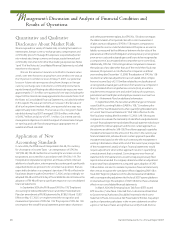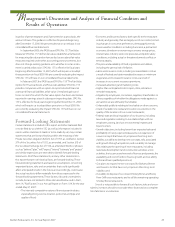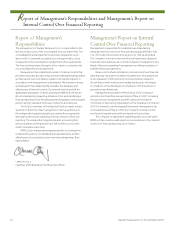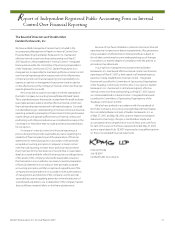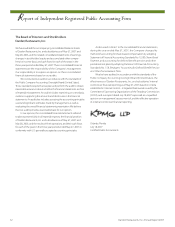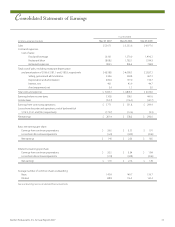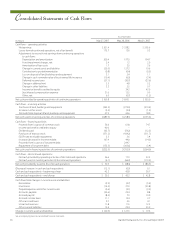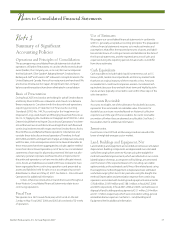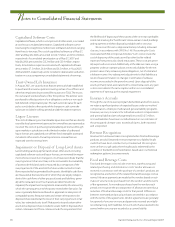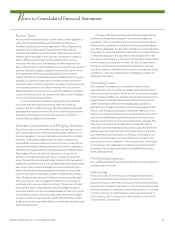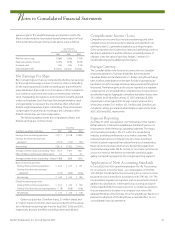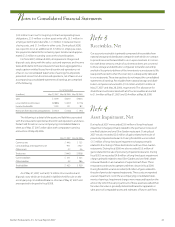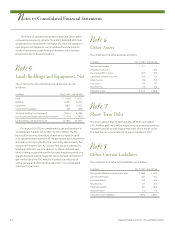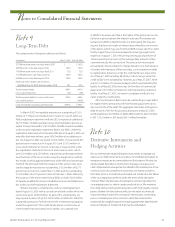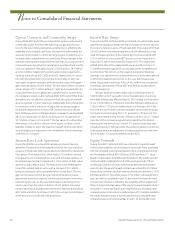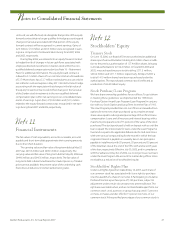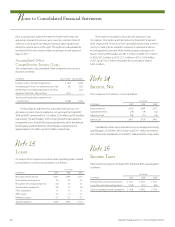Red Lobster 2007 Annual Report Download - page 40
Download and view the complete annual report
Please find page 40 of the 2007 Red Lobster annual report below. You can navigate through the pages in the report by either clicking on the pages listed below, or by using the keyword search tool below to find specific information within the annual report.
38 Darden Restaurants, Inc. Annual Report 2007
Notes to Consolidated Financial Statements
N
Capitalized Software Costs
Capitalized software, which is a component of other assets, is recorded
at cost less accumulated amortization. Capitalized software is amor-
tized using the straight-line method over estimated useful lives ranging
from three to ten years. The cost of capitalized software as of May 27,
2007 and May 28, 2006, amounted to $62.7 million and $56.4 million,
respectively. Accumulated amortization as of May 27, 2007 and
May 28, 2006, amounted to $32.2 million and $25.4 million, respec-
tively. Amortization expense associated with capitalized software
amounted to $7.3 million, $6.6 million and $6.3 million, in fiscal 2007,
2006 and 2005, respectively, and is included in depreciation and amor-
tization in our accompanying consolidated statements of earnings.
Trust-Owned Life Insurance
In August 2001, we caused a trust that we previously had established
to purchase life insurance policies covering certain of our officers and
other key employees (trust-owned life insurance or TOLI). The trust is
the owner and sole beneficiary of the TOLI policies. The policies were
purchased to offset a portion of our obligations under our non-quali-
fied deferred compensation plan. The cash surrender value for each
policy is included in other assets while changes in cash surrender
values are included in selling, general and administrative expenses.
Liquor Licenses
The costs of obtaining non-transferable liquor licenses that are directly
issued by local government agencies for nominal fees are expensed as
incurred. The costs of purchasing transferable liquor licenses through
open markets in jurisdictions with a limited number of authorized
liquor licenses are capitalized as indefinite lived intangible assets and
included in other assets. Annual liquor license renewal fees are
expensed over the renewal term.
Impairment or Disposal of Long-Lived Assets
Land, buildings and equipment and certain other assets, including
capitalized software costs and liquor licenses, are reviewed for impair-
ment whenever events or changes in circumstances indicate that the
carrying amount of an asset may not be recoverable. Recoverability
of assets to be held and used is measured by a comparison of the
carrying amount of the assets to the future undiscounted net cash
flows expected to be generated by the assets. Identifiable cash flows
are measured at the lowest level for which they are largely indepen-
dent of the cash flows of other groups of assets and liabilities, gener-
ally at the restaurant level. If such assets are determined to be
impaired, the impairment recognized is measured by the amount by
which the carrying amount of the assets exceeds their fair value. Fair
value is generally determined based on appraisals or sales prices of
comparable assets. Restaurant sites and certain other assets to be
disposed of are reported at the lower of their carrying amount or fair
value, less estimated costs to sell. Restaurant sites and certain other
assets to be disposed of are included in assets held for disposal when
certain criteria are met. These criteria include the requirement that
the likelihood of disposing of these assets within one year is probable.
Assets not meeting the “held for sale” criteria remain in land, buildings
and equipment until their disposal is probable within one year.
We account for exit or disposal activities, including restaurant
closures, in accordance with SFAS No. 146, “Accounting for Costs
Associated with Exit or Disposal Activities.” Such costs include the
cost of disposing of the assets as well as other facility-related
expenses from previously closed restaurants. These costs are gener-
ally expensed as incurred. Additionally, at the date we cease using a
property under an operating lease, we record a liability for the net
present value of any remaining lease obligations, net of estimated
sublease income. Any subsequent adjustments to that liability as a
result of lease termination or changes in estimates of sublease
income are recorded in the period incurred. Upon disposal of the
assets, primarily land, associated with a closed restaurant, any gain
or loss is recorded in the same caption within our consolidated
statements of earnings as the original impairment.
Insurance Accruals
Through the use of insurance program deductibles and self-insurance,
we retain a significant portion of expected losses under our workers’
compensation, employee medical and general liability programs.
However, we carry insurance for individual workers’ compensation
and general liability claims that generally exceed $0.25 million.
Accrued liabilities have been recorded based on our estimates of
the anticipated ultimate costs to settle all claims, both reported
and unreported.
Revenue Recognition
Revenue from restaurant sales is recognized when food and beverage
products are sold. Unearned revenues represent our liability for gift
cards that have been sold but not yet redeemed. We recognize
revenue from our gift cards when the gift card is redeemed by the
customer or the likelihood of redemption, based upon our historical
redemption patterns, becomes remote.
Food and Beverage Costs
Food and beverage costs include inventory, warehousing and
related purchasing and distribution costs. Vendor allowances
received in connection with the purchase of a vendor’s products are
recognized as a reduction of the related food and beverage costs as
earned. Advance payments are made by the vendors based on esti-
mates of volume to be purchased from the vendors and the terms
of the agreement. As we make purchases from the vendors each
period, we recognize the pro rata portion of allowances earned as a
reduction of food and beverage costs for that period. Differences
between estimated and actual purchases are settled in accordance
with the terms of the agreements. Vendor agreements are generally
for a period of one year or more and payments received are initially
recorded as long-term liabilities. Amounts which are expected to be
earned within one year are recorded as a current liability.


